
This is not the Joker. It is the German actor Conrad Veidt as he appeared in the 1928 film "The Man Who Laughs", playing the tragic figure of Gwynplaine. "The Man Who Laughs" is based on the 1869 novel "The Man Who Laughs/L'Homme qui Rit" by the great Victor Hugo. Hugo's best known works are "Les Misérables" and "Notre-Dame de Paris/The Hunchback of Notre Dame". This is the commonly cited source for the visual inspiration of the Joker. The Joker first appeared in "Batman" #1 in 1940, and was created, to keep it simple, through a synthesis of concepts of Bob Kane, Bill Finger and Jerry Robinson. About the only details agreed upon by the three regarding the creation of the figure that became Batman's archnemesis, and considered by many to be the greatest comic book super villain of all time, is his basis on the joker playing card and on the image of Gwynplaine as depicted in this film.
This lineage is no small matter. In fact it synchronistically directs us to an aspect of the Joker character that is rather startling in its implications. We'll work our way towards that point. There are several intriguing avenues to explore along the way.
Through this facet of the Joker we find the influence of German Chamber Films which is part of the larger movement of Expressionism. These are art modes inherently tied to the gothic, mysticism and the occult, and hugely influential on all the horror fiction that followed. All of these are umbrellaed by the larger Romantic movement, a field in which Victor Hugo is a monumental figure. Likewise, the American super hero comic book, and high fantasy in general, steadily becoming the predominant mode of popular culture, are the natural extension through time of these traditions.
The conceptualization of the Joker, due to this pedigree, as a figure out of Expressionism is an easy thing to affirm if one considers what may be the single most iconic image of the movement.
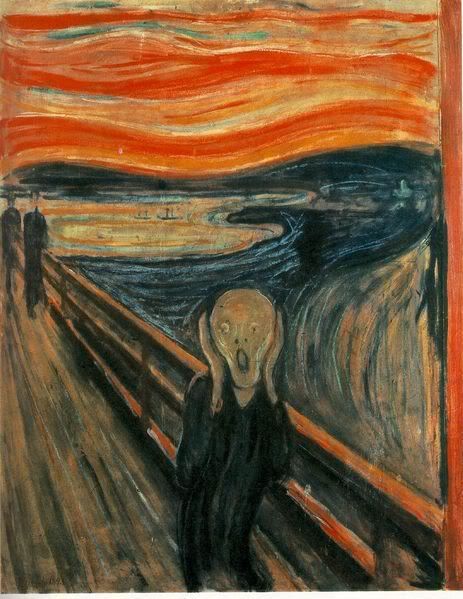
Edvard Munch, "The Scream", 1893
Reverse despair into mirth. Substitute the perception of horror with the projection of horror, and set in motion in the artificial time of the comic book narrative.
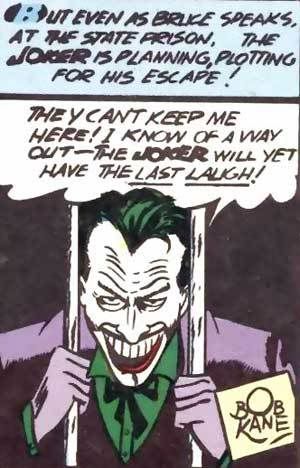
Art by Bob Kane and Jerry Robinson
Note too the use by Munch of the symbolism of the Bridge and of Water in his most famous work. That the artist's official account of the creation of this powerful art piece relates a true experience in no way negates the inherent symbolism involved. We may note as well that the Bridge, if one looks over the edge rather then either end, is not so far removed from the symbolism of the Cliff, Precipice or Ledge (just ask Gwen Stacy) found in many versions of the Fool Trump of Tarot's Major Arcana. In Munch's vision, the subject has assessed the dangers around him and the emotional response is that of abject horror. "The Scream" could perhaps be considered The Fool reversed.
The character Gwynplaine, in Hugo's novel and the German chamber film, suffers his fixed, clown-like expression due to an act of mutilation by a group Hugo termed "the Comprachios", Spanish for "child-buyers". These individuals, sadly based on a real-world activity, made their living through the purposeful mutilation of children to produce sideshow attractions or even private servants for the depraved. Compare this to the Gobblers/General Oblation Board of Philip Pullman's "His Dark Materials" trilogy. This particular facial mutilation is sometimes termed a Glasgow or Chelsea Smile, and it seems to be the basis for the Joker's disfigured appearance in Christopher Nolan's "The Dark Knight". Tim Burton's version of the Joker, played of course by Jack Nicholson, likewise was disfigured, by a bullet that passed through both his cheeks. While these are modifications to the comic book portrayal of the Joker's origin, it in fact brings the character closer to his source material, material I am certain both Nolan and Burton were aware of.


Here we find Veidt again, playing "the Somnambulist" (the figure in black) in the 1920 German Expressionist film "The Cabinet of Dr. Caligari", bringing one of those insidious illuminated, fictional doctors into the mix. The inspiration of the Somnambulist character on Burton's "Edward Scissorhands" is self-evident (as is the visual styling of German chamber movies on his work in general). "Edward Scissorhands", arguably Burton's finest work, was the movie he released following "Batman". The name Veidt, interesting enough, was utilized by Alan Moore in "Watchmen" as the last name of the conspiracy creating Ozymandius. If we trace the etymology, we find the German name Veidt derives from the Latin "vita", meaning life of course. Saint Vitus is a Christian child martyr, tortured to death for his refusal to denounce Christianity, and the patron of actors and comedians. Perhaps you've heard of his dance.
One of the most troubling aspects of Ledger's death, which is increasing rather then decreasing as time passes and new, sometimes contradictory, details come to light, is the very feeling of unreality surrounding it all. This is an aspect well addressed by Ben Fairhall's "The Daily Behemoth" article Joker and Jokerman where he addresses viral marketing campaigns (utilized for promotion of "The Dark Knight", specifically regarding the appearance of Ledger's Joker) and Alternate Reality Gaming.
These related topics are modern day, internet based extensions of the basic hoax, an action, large and small scale, likely as old as human civilization itself. And this is no small matter. Don't get me wrong. I'm not saying that Heath Ledger's death is a hoax, or anything other then what it has been presented as. Of course the greatest hoaxes of all are the ones that are never detected. I'm afraid we live in the Age of Hoax, where much of what we are presented with as event, fact and history are either modifications or outright fabrications.
H.P. Lovecraft utilized the structure of the hoax to great effect in the cration of much of his supernatural fiction. Lovecraft was a devotee of Edgar Allen Poe, credited with the creation of detective fiction. A detective, often, is engaged in the act of exposing hoaxes. Batman, the Dark Knight Detective, made his debut in "Detective Comics". And still we are comfortably in the domain of Romanticism.
One hoax that is very famous and still has considerable legs are the forgeries of French royalist Pierre Plantard, including his list of supposed Grand Masters of the Priory of Sion, which served as part of the basis of Dan Brown's "The Da Vinci Code", and its nonfiction predecessor (and inspiration) "The Holy Blood and the Holy Grail", by Henry Lincoln, Michael Baigent and Richard Leigh.
Baigent and Leigh sued Dan Brown for plagiarism, and lost. To me, as a fan of both works, the connection between their books was self-evident. I always wondered if the law suit was itself a hoax, a great publicity stunt for the film version of Brown's novel and even more so for the more obscure further writings of Leigh and Baigent. Richard Leigh died just months ago, in late November 2007. Ron Howard and Tom Hanks will reteam for the prequel of "The Da Vinci Code", "Angels and Demons", scheduled for release in May of 2009.
Now, many would like to simply dismiss "The Holy Blood and the Holy Grail" as a whole due to Plantard's forgeries. Of course it is far from being that simple. The best hoax is the one that sits closest to the truth. It is not the point of this article to debate these matters. What is easy to recognize, however, is that many of the Grand Masters on Plantard's list were obviously occultists, including famous alchemists, Nicolas Flamel, Robert Fludd, and Johann Valentin Andrea. The occult nature of the works of Da Vinci are self-evident. The same is true of the supposed 24th Grand Master on the list, Victor Hugo.
Hugo's alchemical insights were such as to be heavily noted by Fulcanelli in "Le Mystère des Cathédrales". There are numerous references in "The Hunchback of Notre Dame" to Nicholas Flamel, to a degree that Hugo's famous novel could be considered a love letter to the famed alchemist, who I am not convinced was not a predecessor of Hugo's in an esoteric organization, at the very least in spirit. Another obvious fan of Flamel's is author J.K.Rowling, who featured the famed 15th century alchemist and his wife Perenelle as still living in the late 20th century in "Harry Potter and the Philosopher's Stone", the first book of her seven part series, clearly establishing the alchemical underpinnings of her children's fantasy at the story's onset.
And so we find the character of the Joker clearly a product of the esoteric stream. Alan Moore I'm certain was aware of these facets when he presented the sociopathic clown as a tragic figure in his retelling of the Joker's origin, "Batman: The Killing Joke" in 1988.
"Batman: The Killing Joke" represents a back-story for the Joker originally presented in "Detective Comics" #168, February, 1951. It was of course much lighter fare as originally told, but the alchemical undercurrent is present none the less.
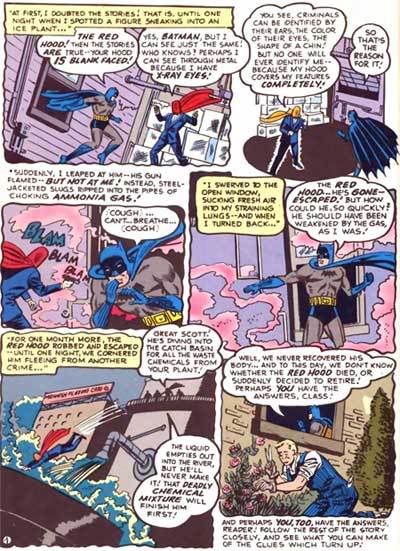
Art by Sheldon Moldoff and George Roussos
Note that Batman is recounting this past adventure as as a guest Professor of criminology at an imaginary Gotham City college.
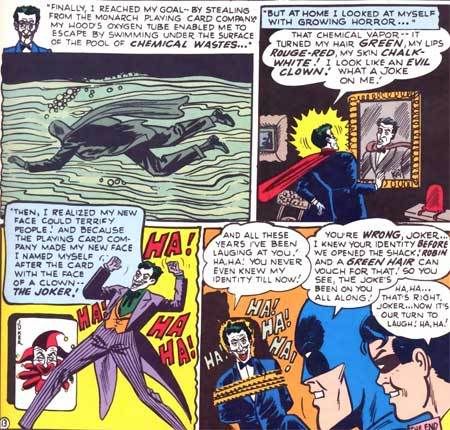
Art by Sheldon Moldoff and George Roussos.
And again, I find this portion of the story very similar in ways to certain symbolic elements of "The Scream" once we look past the exoteric levels of the works. For that matter, Hugo's "The Man Who Laughs" ends with Gwynplaine, his blind, pure-hearted true love Dea, and their foster-father Ursus sailing away from England for the continent. While Ursus slumbered Dea professed her love for Gwynplaine and then abruptly died. Ursus awakened to find no sign of Gwynplaine, who we can be certain threw himself over the ship's rail in sorrow and drowned. The man who was the Red Hood "died" in the chemical bath and was reborn as the Joker. Moore made the tragic precedent more plain in "The Killing Joke", as the Red Hood event occurred following the unexpected death of his pregnant wife. The death of Gwen Stacy contains many of these same elements in somewhat different combinations.
It was in no way my intent to link matters between these articles on Heath Ledger and the Joker, and my last article, What's The Story? Mourning Glory, which dealt with my continuing exploration of the esoteric symbolism of Spider-Man and his first true love Gwen Stacy. And yet we find several convergences just the same. The symbolism of Bridges, alchemical origins, the films of Ron Howard, a character named Gwyn/Gwen, the death of the maiden, and characters representing the Fool Trump of the Tarot.
I mentioned the Joker as the Fool in Part One, and it is an easy thing to recognize. How interesting that in the Joker's first appearance, due to the propensity of comic book characters to make plays on words, the Batman likewise associated himself with a playing card.
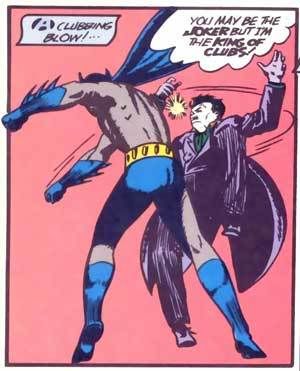
Art by Bob Kane and Jerry Robinson
Clubs equal Wands. Look it up, it's a highly appropriate signifier for Batman/Bruce Wayne.
No comments:
Post a Comment